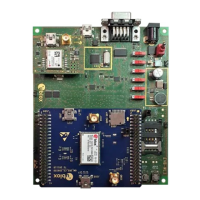SARA-R5 series - System integration manual
UBX-19041356 - R04 System description Page 27 of 118
C1-Public
1.7.2 GNSS antenna RF interface (ANT_GNSS)
☞ The GNSS antenna RF interface is not supported by SARA-R500S and SARA-R510S modules.
☞ For additional information regarding the GNSS system, see the SARA-R5 series positioning
implementation application note [18].
SARA-R510M8S modules provide an RF interface for connecting the external GNSS antenna. The
ANT_GNSS pin represents the RF input reception of GNSS RF signals.
The ANT_GNSS pin has a nominal characteristic impedance of 50 and must be connected to the Rx
GNSS antenna through a 50 transmission line to allow proper RF reception. As shown in Figure 4,
the GNSS RF interface is designed with an internal DC block, and is suitable for both active and/or
passive GNSS antennas due to the built-in SAW filter followed by an additional LNA in front of the
integrated high performing u-blox M8 concurrent position engine.
1.7.2.1 GNSS antenna RF interface requirements
Table 7 summarizes the requirements for the GNSS antenna RF interface. See section 2.4.3 for
suggestions to correctly design antennas circuits compliant with these requirements.
50 nominal characteristic impedance
The impedance of the antenna RF connection must match the
50 impedance of the ANT_GNSS port.
BeiDou 1561 MHz
GPS / SBAS / QZSS / Galileo 1575 MHz
GLONASS 1602 MHz
The required frequency range of the antenna connected to
ANT_GNSS port depends on the selected GNSS constellations.
S
11
< -10 dB (VSWR < 2:1) recommended
S
11
< -6 dB (VSWR < 3:1) acceptable
The return loss or the S
11
, as the VSWR, refers to the amount of
reflected power, measuring how well the antenna RF connection
matches the 50 characteristic impedance of the ANT_GNSS
port.
The impedance of the antenna termination must match as
much as possible the 50 nominal impedance of the
ANT_GNSS port over the operating frequency range, reducing
as much as possible the amount of reflected power.
The antenna gain defines how efficient the antenna is at
receiving the signal. It is important providing good antenna
visibility to the sky, using antennas with good radiation pattern
in the sky direction, according to related antenna placement.
17 dB minimum, 30 dB maximum
The antenna gain defines how efficient the antenna is at
receiving the signal. It is directly related to the overall C/No.
Noise figure
(active antenna)
Since GNSS signals are very weak, any amount of noise
degrades all the sensitivity figures of the receiver: active
antennas with LNA with a low noise figure are recommended.
GNSS signals are circularly-polarized. The purity of the antenna
circular polarization is stated in terms of axial ratio (AR),
defined as the ratio of the vertical electric field to the horizontal
electric field on polarization ellipse at zenith.
Table 7: Summary of GNSS antenna RF interface requirements

